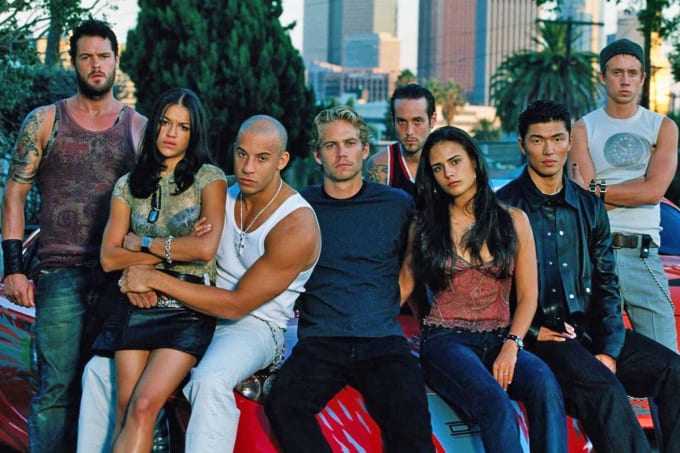Fast and Furious: The Legacy Behind the ‘Family First’ Memes
Written by SOURCE on July 9, 2021
The Fast and the Furious begins with two important sequences. The first shows a group of souped-up, jet-black Honda Civics roaring into the night in pursuit of a truck full of DVD players. Their hunt is precise, like a pack of wolves cornering and taking down a wounded animal. The second is stark in contrast, as the glare of the Los Angeles sun beats down on baby-faced Brian O’Conner (Paul Walker) careening his car through the empty parking lot of Dodger Stadium. The differences aren’t subtle, but they’re extremely telling in what they convey—from the very start, the Fast & Furious franchise has always been about belonging.
Inspired by Kenneth Li’s 1998’s “Racer X” article for Vibe, the 2001 movie roared onto screens, well aware of what it was right from the ignition. Sure, look under the hood, and you’ll notice the chassis of Point Break; Walker’s “Brian Earl Spilner” has been tasked by the LAPD to go deep undercover to ascertain the identity of the thieves making quick work out of semi-trucks in the area. His natural inclination leads him to suspect the jackers are Dominic Toretto (Vin Diesel) and his crew—girlfriend Letty (Michelle Rodriguez), hacker extraordinaire Jesse (Chad Lindberg), loose cannon Vince (Matt Schulze), and trustworthy stalwart Leon (Johnny Strong). This is why Brian keeps showing up to the Toretto family cafe to get a tuna sandwich from Mia Toretto (Jordana Brewster). But the remaining parts of the car—to continue this silly metaphor—are original, especially as Brian deepens his romance with the Toretto family. Brian is fated to end up with Mia from the second we see her, but the real dalliance is between him and Dom. As Mia tells Brian, Dom is “like gravity… everything just gets pulled to him.” There’s alluring freedom to Dom’s life, so it’s unsurprising Brian—and eventually, many others—fall into his orbit.
But it’s more than just freedom or the ability to live your life a quarter-mile at a time. No, at its core, the Fast & Furious franchise runs on love. Love propels the story forward like a shot of NOS and grounds the series when it threatens to swerve off the road. This earnestness may feel decidedly corny in our modern era, but these movies embraced it from the very start. There’s a sense this didn’t develop until Chris Morgan’s scripts had Dom spouting platitudes about family, but the origins of those themes start in The Fast and the Furious. Joining the Toretto family means a life full of outdoor gatherings, Coronas, cars, and maybe even a big payday along the way. It also means unequivocal trust—an uncomplicated belief in a world full of complications. This trust is why Dom is (ultimately) accepting of Brain despite his yo-yo-ing back and forth between life as a cop and his status as a member of Dom’s family. The understanding between Brian and Dom, even as they work at cross-purposes, is one of mutual respect; Brian finds an outlet, one he’s searched for since he boosted a car and ended up in juvie, while Dom finds a brother—one who can replace the sibling he fell out with long ago.

In the same way Dom opened a seat at the table for Brian, so has the franchise itself. The love of cars is inherently multicultural, so it makes sense for the world of Fast & Furious to reflect it on screen by assembling an all-embracing, all-inclusive, all-global crew including Tyrese Gibson, Ludacris, Eva Mendes, Devon Aoki, Bow Wow, Sung Kang, Ozuna, Tego Calderón, Gal Gadot, Elsa Pataky, Nathalie Emmanuel, Dwayne Johnson, Luke Evans, Jason Statham, Charlize Theron, and Dame Helen Mirren. Some of these actors are friends, others are foes. Yet they all worked to provide a far more expansive and therefore richer world for audiences to enjoy—and relate to—as Dom and his crew transitioned from working-class thieves to globe-trotting heroes in pursuit of dastardly drug leaders, murderous mercenaries, cyberterrorists, and numerous MacGuffins. This extends behind the camera; the franchise has strived for different viewpoints, with directors like John Singleton, Justin Lin, James Wan, and F. Gary Gray taking turns helming different installments. It’s as if to say, if you don’t see yourself in other movies, the Fast & Furious franchise has always had a home for you.
Twenty years later, the success and legacy of The Fast and the Furious can’t be measured by the franchise’s box office profits, movie stars mined, hashtags spawned, quotable lines, amount of striking set pieces or number of Coronas consumed. Those things matter, sure, but it’s so much simpler than that. I think back to the duality of those opening sequences, how striking they are in their opposition. Then I remember the quote from Ted Levine’s Sgt. Tanner: “There’s all kinds of family, Brian. And that’s a choice you’re gonna have to make.” The film’s closing moment makes Brian’s—and our—decision clear. Familial bonds are worth everything and can make it feel as if anything is possible—whether it’s driving a safe through Rio, jumping off a tank, or flying a car between buildings. What’s more powerful, universal, and meaningful than that?




